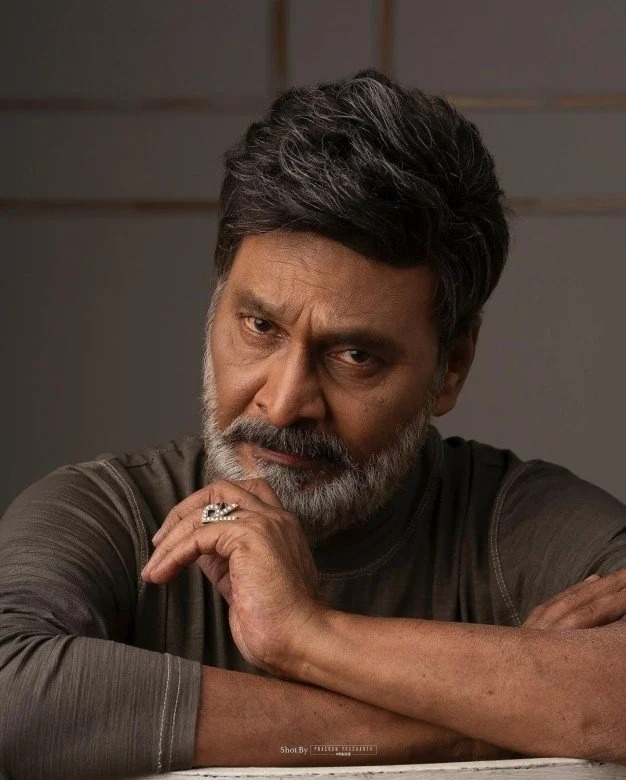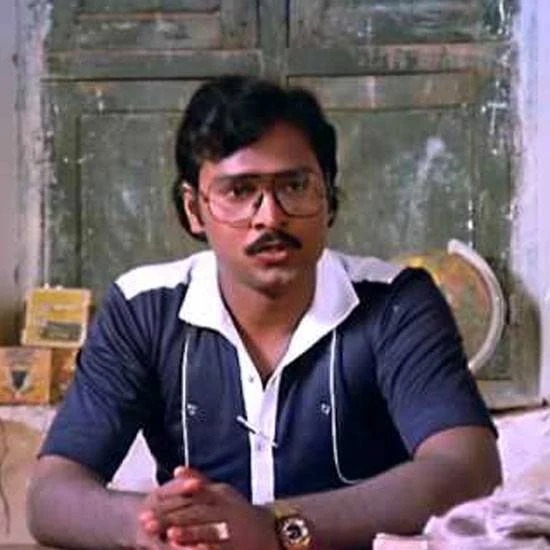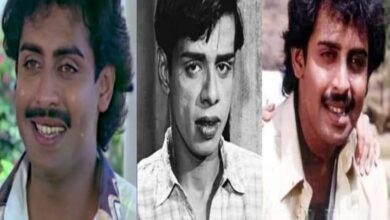K.Bhagyaraj Legacy: Tamil Film’s Creative Genius

K. Bhagyaraj, born Krishnasaamy Bhagyaraj on January 7, 1953, is a prominent and versatile figure in the Indian film industry, primarily known for his contributions to Tamil cinema. His life has been a fascinating journey of creativity, innovation, and success.

Entry into Cinema:
Bhagyaraj’s entry into the world of cinema was marked by determination and perseverance. He initially started as a scriptwriter, crafting stories and screenplays for various Tamil films. His breakthrough came when his script for the film “Sigappu Rojakkal” (1978) was accepted and became a success.
Bhagyaraj’s contributions and success have inspired generations of filmmakers, encouraging them to experiment with storytelling and address important social issues through cinema.

Bhagyaraj, the Tamil Actor-Director, and the sensational story-teller
Innovative Storytelling:
He’s celebrated for his innovative storytelling prowess. During the 1980s, he emerged as a trailblazing director and screenwriter whose narratives broke away from conventional norms, captivating audiences with their freshness and relatability.
One of Bhagyaraj’s defining features as a storyteller was his ability to craft tales that resonated with the common man. He had an uncanny knack for delving into the everyday struggles, dreams, and emotions of ordinary people. His scripts were a mirror to society, addressing social issues and human relationships in a manner that struck a chord with audiences.
Furthermore, Bhagyaraj’s scripts were infused with wit, humor, and incisive social commentary. His dialogues and one-liners became legendary, often quoted and imitated by fans. He possessed a remarkable talent for infusing humor into serious subjects, making his films both entertaining and thought-provoking.
Bhagyaraj’s storytelling extended beyond mere entertainment; it carried profound messages. His films explored themes such as family values, gender dynamics, and societal norms. Whether through comedies or dramas, he managed to convey powerful messages while keeping viewers engaged.
In a time when the Tamil film industry was evolving, K. Bhagyaraj was at the forefront of this transformation, pushing boundaries with his innovative storytelling. His ability to craft compelling narratives that mirrored the realities of everyday life cemented his reputation as a visionary filmmaker, leaving an indelible mark on Tamil cinema.
Relatable Characters:
He created characters that were relatable to the common man. His films often depicted the struggles, aspirations, and emotions of ordinary people, making them more appealing to a wide audience.
Bhagyaraj has created several iconic and relatable characters in his movies that became sensations among Tamil audiences. Some of these characters include:
- Chandran (Mundhanai Mudichu): Played by Bhagyaraj himself, Chandran is a character known for his witty and humorous dialogues. His unique take on married life and relationships resonated with the audience, making him a beloved character.
- Manohar (Indru Poi Naalai Vaa): Manohar, portrayed by Bhagyaraj, is a character known for his charming and mischievous personality. His antics and romantic escapades made him endearing to viewers.
- Sathyamoorthy (Ninaithale Inikkum): Played by Rajinikanth, this character was a significant part of the film’s success. Sathyamoorthy’s portrayal of a caring and supportive friend struck a chord with the audience.
- Raja (Avasara Police 100): Raja, played by Bhagyaraj, is a character in a comedy of errors. His humorous situations and the way he deals with them make him a memorable character.
- Ramu (Andha 7 Naatkal): Sivakumar’s character Ramu in this film is portrayed as a loving husband dealing with a peculiar situation. His sincerity and dedication to his family were appreciated by the audience.
These characters are just a few examples of the many relatable and memorable roles created by K. Bhagyaraj in his films. They resonated with Tamil audiences due to their authenticity, humor, and ability to reflect the everyday experiences and emotions of the common people, contributing to Bhagyaraj’s sensational status in the industry.
Scriptwriting:
Bhagyaraj was a prolific writer, and his screenplays were known for their wit, humor, and social commentary. His dialogues and one-liners became popular among fans.
His scripts have consistently resonated with Tamil audiences for several reasons:
- Relatability: Bhagyaraj’s scripts often revolve around everyday life and relatable situations, making them accessible and engaging for a wide range of viewers. Audiences could see themselves in the characters and scenarios he created.
- Social Commentary: His scripts often carried underlying social messages and commentary, addressing important issues while still being entertaining. This dual approach allowed audiences to connect with the stories on both emotional and intellectual levels.
- Humor: Bhagyaraj’s scripts were known for their wit and humor. He had a unique ability to infuse comedy into serious subjects, providing audiences with both laughter and food for thought.
- Character Depth: His scripts gave depth and complexity to characters, allowing actors to deliver memorable performances. These well-developed characters resonated deeply with the audience.
- Dialogues: Bhagyaraj’s sharp and clever dialogues became legendary. Many of his one-liners and catchphrases from his films are still popular and frequently quoted by fans.
- Narrative Innovation: He was not afraid to experiment with narrative structures and storytelling techniques. This innovation kept his scripts fresh and exciting, captivating audiences with unexpected twists and turns.
- Cultural Relevance: Bhagyaraj’s scripts often touched upon cultural and societal norms, reflecting the times in which they were made. This cultural relevance made his films relatable to their contemporary audiences.
Bhagyaraj’s scriptwriting was a sensation among audiences because it combined relatability, humor, social commentary, and narrative innovation. His ability to create scripts that entertained, educated, and resonated with people contributed significantly to his enduring popularity in the Tamil film industry.
Actor-Director:
He often acted in his own films, which added to their appeal. His performances as an actor were well-received, and audiences connected with him both as a director and an actor.
K. Bhagyaraj’s dual role as an actor-director has been a sensation among audiences for several compelling reasons:
- Versatility: Bhagyaraj demonstrated remarkable versatility by excelling in both acting and directing. As an actor, he portrayed a wide range of characters, from comical to dramatic, showcasing his ability to connect with diverse audience preferences.
- Personal Connection: Audiences often found it easier to connect with Bhagyaraj’s characters because he was not only the director but also the face of his films. This personal connection added depth to his characters and storytelling.
- Consistent Quality: His films, both as an actor and director, consistently delivered high-quality entertainment. Whether in the director’s chair or in front of the camera, Bhagyaraj maintained a standard of excellence that audiences came to expect.
- Memorable Performances: Bhagyaraj’s performances as an actor were memorable and iconic. Characters like Chandran from “Mundhanai Mudichu” and Manohar from “Indru Poi Naalai Vaa” left a lasting impression on the audience.
- Influence: His ability to wear both hats – actor and director – influenced the way films were made in the Tamil industry. Many other actors and directors were inspired by his success and followed suit, leading to a significant impact on the industry.
- Balancing Act: Bhagyaraj demonstrated a rare skill in balancing his roles as an actor and director, ensuring that neither aspect of the filmmaking process suffered. This commitment to both facets of filmmaking was appreciated by the audience.
K. Bhagyaraj’s unique position as an actor-director in the Tamil film industry allowed him to connect with audiences on multiple levels.
Successful Films:
Bhagyaraj delivered a string of successful films in the 1980s, including “Andha 7 Naatkal,” “Mundhanai Mudichu,” “Indru Poi Naalai Vaa,” and “Ninaithale Inikkum.” These movies were not only commercially successful but also critically acclaimed.
Here are some of his most notable and successful films:
- Mundhanai Mudichu (1983): This film, which Bhagyaraj directed and acted in, was a massive hit. It’s remembered for its witty humor and iconic character, Chandran.
- Indru Poi Naalai Vaa (1981): Another film in which Bhagyaraj played a prominent role, this comedy-drama was a significant success, known for its memorable humor and music.
- Andha 7 Naatkal (1981): This critically acclaimed movie features a compelling storyline and strong performances.
- Dhavani Kanavugal (1984): This romantic drama was a box-office hit and showcased his storytelling skills.
- Avasara Police 100 (1990): Bhagyaraj’s portrayal of Raja in this comedy film received positive reviews and contributed to the film’s success.
- Oru Kai Osai (1980): Focussed on social issues and was well-received by both critics and audiences.
- Enga Chinna Rasa (1987): Bhagyaraj, the actor played a crucial role in this family drama, which touched upon themes of love, sacrifice, and family bonds.
- Chinna Veedu (1985): This comedy film directed by Bhagyaraj was a commercial success and featured his signature style of humor.
- Raasukutti (1992): A Pure Family Drama, appreciated for its storytelling and performances.
Focus on Family and Relationships:
Many of Bhagyaraj’s films focused on family values, relationships, and the dynamics of human emotions, which struck a chord with the conservative Tamil audience.
Renowned for his distinctive focus on family and relationships in his movies, making them a central theme in many of his films. His ability to depict the intricacies of human connections and family dynamics has been a hallmark of his storytelling. Here’s why Bhagyaraj’s treatment of family and relationships is significant in his movies:
- Relatability: Bhagyaraj’s films often revolve around everyday familial and interpersonal situations, making them highly relatable to the average viewer. Audiences see their own lives reflected in his narratives.
- Realistic Portrayals: He presents characters and situations that feel genuine and true to life. This authenticity resonates with audiences who appreciate the realistic depiction of family and relationships.
- Emotional Depth: Bhagyaraj delves deep into the emotional aspects of family bonds, love, marriage, and friendship. His films explore a wide range of emotions, from love and joy to conflict and reconciliation.
- Social Commentary: While focusing on family and relationships, Bhagyaraj often weaves in social commentary. His films tackle societal norms and expectations, shedding light on issues like dowry, gender roles, and generational conflicts.
- Humor and Entertainment: Even within family-centric themes, Bhagyaraj infuses humor and entertainment. His films strike a balance between delivering meaningful messages and providing lighthearted entertainment, making them appealing to a broad audience.
- Character Development: Bhagyaraj pays careful attention to character development, allowing viewers to connect deeply with the protagonists and their journeys within the context of family and relationships.
- Enduring Themes: The themes of love, sacrifice, and the importance of familial bonds are enduring and timeless. Bhagyaraj’s exploration of these themes ensures that his movies remain relevant and cherished by successive generations.
Some notable films where Bhagyaraj’s focus on family and relationships shines include “Mundhanai Mudichu,” “Indru Poi Naalai Vaa,” “Avasara Police 100,” and “Dhavani Kanavugal.” His unique ability to blend relatability, emotion, and social commentary in his treatment of family and relationships has contributed to his enduring popularity in Tamil cinema.
Introduction of New Talent:
He introduced and nurtured new talents in the industry, both in front of and behind the camera, contributing to the growth of the Tamil film industry.
Adaptation to Changing Times:
Bhagyaraj had the ability to adapt to changing trends and tastes in cinema. His ability to stay relevant in the evolving landscape of Tamil cinema also contributed to his popularity.
His remarkable ability to adapt to changing times in Tamil cinema has been a key factor in his enduring success. Here’s how he has consistently evolved with the industry:
- Genre Flexibility: Bhagyaraj has worked in various genres, from romantic dramas to comedies to social issue-based films. He adapted his storytelling style to cater to the evolving tastes and preferences of Tamil cinema audiences.
- Contemporary Themes: He consistently addressed contemporary social and cultural issues in his films, ensuring that his narratives remained relevant to the times. His films often reflected the changing societal norms and values.
- Technology Integration: Bhagyaraj embraced advancements in filmmaking technology. His later films showcased improved production values and incorporated modern filmmaking techniques.
- Multi-Faceted Roles: He seamlessly transitioned from being an actor to a director and screenwriter, showcasing his versatility in different aspects of filmmaking. This adaptability allowed him to stay relevant in the industry.
- Mentoring New Talent: Bhagyaraj continued to introduce and mentor new talent in the industry, staying connected with the emerging generation of actors, writers, and directors.
- Audience Engagement: He paid close attention to audience feedback and preferences, making adjustments to his storytelling based on their reactions. This ensured that he maintained a strong connection with his fan base.
- Cultural Sensitivity: Bhagyaraj was attuned to the cultural shifts and sensibilities of the Tamil audience. His films resonated with the cultural nuances of different time periods.
- Balancing Tradition and Innovation: While adapting to changing times, he also maintained a connection with the traditional elements of Tamil cinema, respecting the industry’s heritage.
His contributions to the industry continue to influence and inspire new generations of filmmakers and artists.
A few trivia facts:
- In Andha 7 Naatkal movie, Bhagyaraj – a Tamilian plays a Malayali character while Ambika – a Malayali, plays a Tamil woman
- Bhagyaraj directed the Hindi movie “Aakhri Rasta” with Amitabh Bachchan in the lead which was a remake of his guru Bharathi Raja’s direction “Oru Kaidhiyin Diary” which had a story by him
- His 1990 directorial “Avasara Police 100” features scenes from an erstwhile 1977 shelved MGR movie named “Anna Nee En Dheivam”
Overall, K. Bhagyaraj’s ability to connect with the audience through his storytelling, relatable characters, and unique style of filmmaking made him a sensational figure in the Tamil film industry during the 1980s. His contributions to Tamil cinema have left a lasting impact, and he continues to be a respected figure in the industry.

